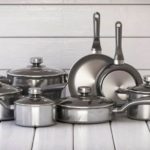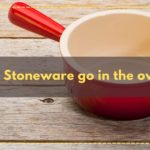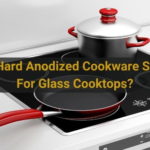Different Types of Cookware (Detailed Guide)

Cookware is a basic necessity in any kitchen. It is very important to select the right cookware for your cooking needs. There are many types of cookware materials, it can be a little overwhelming because of so many choices.
You might think which one is the best? Which material lasts longer? Which is more versatile?
If you are a beginner and don’t know where to start, this detailed guide will help you understand the different types of cookware. By the end of this guide, you will know the best cookware for your needs.
The most common types of cookware are made up of metals like stainless steel, aluminum, cast iron, copper, and carbon steel. They are durable and can last for a long time if properly cared for.
They all have their own set of advantages and drawbacks, so it’s just a question of selecting the one that works best for your cooking style. So, let’s discuss each type in detail: Their pros and cons and which type of material is best suited for which type of cooking.
Types Of Cookware
- Stainless Steel
- Cast Iron
- Enameled Cast Iron
- Aluminum
- Anodized Aluminum
- Carbon Steel
- Copper
- Nonstick
- Ceramic
1. Stainless Steel Cookware
So let’s start with stainless steel cookware.
Stainless steel is one of the most popular types of cookware. It is made of chromium and nickel which makes it durable and resistant to corrosion.
Stainless steel cookware is available in various grades. The lower the grade, the less chromium and nickel it contains. 18/10 is the highest quality stainless steel which contains 18% chromium and 10% nickel. It is also the most expensive type of stainless steel.
If you are looking for a less expensive option, you can go for 18/0 stainless steel which contains 18% chromium and 0% nickel. It is not as durable as 18/10 but it is still good quality cookware.
However, Stainless steel is a poor conductor of heat. So, most of the time it is combined with other metals like aluminum or copper to improve its heat conductivity.
Stainless steel cookware is safe to use as it is non-reactive. It doesn’t leach chemicals into your food even when heated. It is also easy to clean and doesn’t require any special care.
Stainless steel cookware is a good option for cooking at high heat as it is less likely to warp or discolor. It is also oven-safe and can be used for browning and braising. If you are looking for durable and safe cookware, stainless steel is a good option.
Pros:
- It is durable and has a long lifespan.
- It is safe to use as it is non-reactive.
- It is dishwasher safe.-
- It can be used for cooking at high heat.
- Versatile Vessel
- Induction Friendly
Cons:
- Poor conductor of heat.
- Food Sticks.
- High-End Stainless Steel cookware like Tri-Ply stainless steel is expensive
- Not for Beginners
Best suited for:
- Cooking at high heat.
- Browning and braising.
It is a great choice for everyday cooking because it is dishwasher-safe and easy to maintain. Stainless steel cookware is also very versatile, you can use it for multiple cooking methods like frying, sautéing, and even baking.
The only drawback of stainless steel cookware is that (stainless steel alone) is not a good conductor of heat.
Related Post: Stainless Steel vs Aluminum Cookware
2. Aluminum/Anodized Aluminum Cookware
Aluminum is a good conductor of heat and it is light in weight. It is also less expensive than other metals like stainless steel and copper. However, aluminum is a reactive metal which means it will react with acidic food and leach chemicals into your food.
To avoid this, manufacturers coat aluminum cookware with anodized aluminum to make it non-reactive. Anodizing is a process in which the aluminum is exposed to an electrical current which creates a thin layer of oxide on the surface of the metal. This layer makes the aluminum non-reactive and also improves its durability.
Most of the people think that anodizing makes aluminum nonstick but that is not true. However, to make it nonstick, aluminum cookware is coated with a nonstick coating.
Pros
- Even heat distribution
- Lightweight
- Inexpensive
- Nonstick
- Durable
Cons
- Reactive metal
- Not induction Safe
- Not Dishwasher Safe
Best suited for
- Everyday cooking
- Cooking at low to moderate heat
Aluminum cookware is a great choice for everyday cooking as it is light in weight and inexpensive. However, it is not suitable for cooking at high heat as it can warp and the nonstick coating can be scratch off if you use metal utensils.
3. Copper Cookware
Copper is another excellent cookware that conducts heat very well. It is a soft metal so it heats up quickly and evenly. Copper cookware is often lined with other metals like stainless steel or tin. Tin is a softer metal than copper so it needs to be replaced more often.
Stainless steel is a harder metal. So, it is a better option for lining copper cookware. Copper cookware is also beautiful to look at and it adds a touch of elegance to your kitchen.
But it is also expensive and needs special care. With usage the color of copper cookware changes from shiny reddish to dull brown. You can use lemon and salt to clean it and bring back its shine.
Pros
- It conducts heat very well.
- It is beautiful and adds a touch of elegance to your kitchen.
Cons
- It is expensive.
- Needs special care.
- Not Induction Safe
Best suited for
Copper cookware is best suited for cooking at high heat. It heats up quickly and evenly so it is perfect for searing and sautéing.
4. Cast Iron
Cast iron is one of the heavy and oldest types of cookware. It is made by heating iron until it becomes liquid and then pouring it into a mold. Cast iron is very durable and can last for generations if properly cared for.
Cast Iron is best when it comes to heat retention and that’s why it is often used for slow-cooking methods like braising and stewing.
It can withstand high temperatures and is perfect for cooking at low and slow temperature. It is also a good choice for searing and browning as it can reach very high temperatures.
Like Aluminum, Cast iron cookware is also not the best choice for cooking acidic food as it can react with the acid and leach into the food.
However, it may rust if it is not properly seasoned or if it is left wet for a long time. It is also not dishwasher-safe and needs to be cleaned by hand. With seasing and frequent usages it develops a patina which make it more nonstick .
Pros
- It is very durable.
- It can be used on all cooking surfaces including induction.
- Retains Heat Well
- Long lasting material
- It can reach very high temperatures.
Cons
- It is heavy and difficult to handle.
- It rusts easily if not properly seasoned
- It is not dishwasher-safe.
Best suited for
- Cooking at low and slow temperature.
- Searing and browning.
- Braising and stewing.
If you are looking for a durable cookware that can be passed down from generations, cast iron is a good choice. However, it is not the best choice for everyday cooking as it is difficult to handle and not dishwasher-safe.
Also Read: Non-Stick vs Cast Iron
5. Enameled Cast Iron
Enameled cast iron is a type of cookware that has a enamel coating on the surface. The enamel coating is usually made from porcelain. Enameled cast iron cookware is very durable and has a long lifespan.
It is also a good conductor of heat and retains heat well. The difference comes in with the enamel coating. The enamel coating makes it more nonstick and also prevents it from rusting.
Enameled cast iron is a good choice for cooking acidic food as the enamel coating prevents the food from coming into contact with the iron. It is also dishwasher-safe and doesn’t require any special care.
On top of that the exterior finish of the cookware is very smooth and stylish that can add a pop of color to your kitchen.
However, it is more expensive than traditional cast iron and the enamel coating can chip off over time with use and it is also not scratch-resistant.
Pros
- It has a long lifespan.
- It is dishwasher-safe.
- The enamel coating makes it more nonstick.
- Prevents rust
- Doesn’t requires Seasoning
- Smooth surface
Cons
- The enamel coating can chip off over time.
- It is not scratch-resistant.
- It is more expensive than traditional cast iron.
Best suited for
- Cooking acidic food.
- Using on Glass Top Stove
If you are the one who want to buy cast iron but are worried about rusting and seasoning then enameled cast iron is a good choice for you as it doesn’t require any special care. Though it is more expensive than traditional cast iron, it is worth the investment.
6. Carbon Steel
Have you ever seen wok in Chinese restaurant? Chances are it is made from carbon steel. Carbon steel is a type of cookware that is made from iron and carbon. It is also a good conductor of heat and is often used in professional kitchens.
Carbon steel is a best alternative to cast iron and is light in weight and has a smooth surface. However, carbon steel cookware is more expensive and is not as durable as cast iron and it is also not dishwasher-safe. It is also more difficult to season than cast iron.
It also delivers a delicious grilled taste. It will also stay naturally nonstick as long as it is properly seasoned.
Read Also: Carbon Steel vs Stainless Steel
Pros
- It is light in weight.
- It is much more responsive to heat than cast iron
Cons
- Not as durable as cast iron.
- Not dishwasher-safe.
- More difficult to season.
Best suited for:
Sautéing, stir-frying and deep-frying.
If you are looking for light weight and easy to handle frying pan, carbon steel is a good choice. However, it is not as durable as cast iron and it is also not dishwasher-safe.
7. Nonstick Cookware
Nonstick cookware by material is made with a variety of different materials. The most common nonstick cookware is made with aluminum or copper.
However, different type of metal is coated with a coating that prevents food from sticking to the surface. This coating is usually made from Teflon or ceramic. Nonstick cookware is very popular as it makes cooking and cleanup much easier.
Read More: Non-Stick vs Stainless Steel Cookware
Teflon
Teflon is the first ever nonstick coating that was used on cookware. It is made from a plastic polymer and it is very slippery. Teflon is still being used on cookware today but the current Teflon cookware is much safer than the early versions.
Pros
- It is very easy to use and cleanup.
- It is affordable.
- Durable as compared to ceramic
- Great nonstick properties
Cons
- Reputation for being unsafe
- Not environment friendly
Ceramic
Ceramic is another newly developed nonstick coating. Ceramic coating is made from inorganic materials, and it is environmentally friendly, safe to use and doesn’t release any toxic fumes when heated.
Read More:
Pros
- It is environmentally friendly.
- Available in different colors.
- Doesn’t release any toxic fumes when heated.
Cons
- Expensive
- Coating can scratch and flake off over time.
- Best suited for Cooking at low and moderate temperature.
The different between Teflon and Ceramic Coating is that ceramic coating is Teflon is much more durable and doesn’t chip off easily. It is also scratch resistant and can withstand high heat.
However, ceramic is more expensive than Teflon and in ceramic cookware we tend to see differen color options which can add a pop of color in your kitchen.
The quality of ceramic vary from brand to brand so make sure to do your research before purchasing one.
Final Thoughts
So, now the question may arise in your mind that which one is the best cookware material?
The answer to this question is that there is no single best cookware material as each material has its own pros and cons.
It all depends on your own cooking needs, preferences and the level of experence you have in the kitchen.
If you are just starting out, we recommend going with nonstick cookware as it is much easier to use. Once you get more experienced, you can experiment with different materials and find out which one works best for you.
Also Read:




